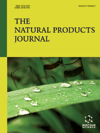- Home
- A-Z Publications
- Natural Products Journal, The
- Previous Issues
- Volume 12, Issue 4, 2022
Natural Products Journal, The - Volume 12, Issue 4, 2022
Volume 12, Issue 4, 2022
-
-
Naringenin Ameliorates Palmitic Acid-induced Fatty Acid Stress in Hepatocytes
More LessAuthors: Subhajit Maity, Partha Chakrabarti and Abhay S. ChakrabortiType 2 diabetes is strongly associated with the development of insulin resistance in metabolically active tissues. Non-alcoholic fatty liver disease (NAFLD) is considered to be a manifestation of hepatic insulin resistance. Saturated fatty acids such as palmitic acid (PA) induce insulin resistance, which may be studied for therapeutic prevention by herbal agents. In the present study, the role of naringenin, a bioflavonoid, is examin Read More
-
-
-
A Review of Various Pharmacological Effects of Quercetin with its Barriers and Approaches for Solubility and Permeability Enhancement
More LessAuthors: Rakesh Mishra and Shweta KulkarniBackground: Quercetin, one of the most beneficial flavonoids, has been included in the human diet due to its therapeutic effect on health. Recently, quercetin has been gaining scientific attraction for its multifarious activities, including anti-oxidant, anti-inflammatory, antiviral, anti-diabetic, anti-cancer, and anti-arthritic activities and its function in easing some cardiovascular diseases. However, these applications of quercetin in t Read More
-
-
-
Phytochemical Contents, Biological Activities and Therapeutic Applications of Hedera Helix (Ivy Leaf) Extracts: A Review
More LessAuthors: Aya Shokry, Riham El-Shiekh, Gehan Kamel and Amer RamadanBackground: Herbs have long been used as natural therapeutics, and recent controlled clinical studies have confirmed some of the presumed benefits. Hedera helix(ivy leaves) is a valuable common form related to the family Araliaceae. Many herbal preparations include extracts from their leaves as the principle active ingredient. Objective: The objective of this article is to summarize the pharmacological activities and phyto Read More
-
-
-
Lantana undulata Schrank – A New Source of Biological Potential in the Verbenaceae Family
More LessBackground: The presence of condensed tannins, flavonones, flavonols, flavones, xantones, catechins and alkaloids in the ethanolic extract of Lantana undulata leaves has been associated with cytotoxicity and virucidal effect on suid herpesvirus. Objective: To evaluate cellular toxicity, antimicrobial and antioxidant activities, and anti-phlogistic property of the ethanolic extract leaves of Lantana undulata, a plant from the Read More
-
-
-
Cytotoxic and Antibacterial Properties of Resveratrol Oligomers from the Stem Bark of Dryobalanops rappa
More LessAuthors: Agustono Wibowo, Norizan Ahmat, Foo J. Biau, Jian Sheng Loh and Ahmad Sazali HamzahBackground: Dryobalanops rappa is a plant species belonging to the family of Dipterocarpaceae. Nevertheless, the active compounds present in D. rappa have never been investigated. Objective: The aim of this research is to isolate and characterize compounds from Dryobalanops rappa and to study its bioactivity against human MCF-7 breast cancer and A549 lung cancer cell lines and several bacterial strains. Methods: The isola Read More
-
-
-
Bio-guided Studies of Lotus maritimus Aerial Parts and Investigation of their Antioxidant, Tyrosinase and Elastase Inhibitory Activities
More LessBackground: Lotus maritimus L. (Fabaceae) is a perennial herb species with yellow flowers, growing in Europe, Asia, Middle East and Maghreb. Some flavones and flavonols have been identified in their leaves and flowers. Their leaf extract was used as a cellulolytic and antiaging cosmetic ingredient. Objective: The aim of this work was to perform antioxidant, anti-tyrosinase and anti-elastase properties of L. maritimus aeria Read More
-
-
-
Kaempferol-3-O-Rhamnoside Inhibits the Proliferation of Jurkat Cells Through Jun Amino-Terminal Kinase Signaling
More LessAuthors: Melisa I. Barliana, Ajeng Diantini, Anas Subarnas and Rizky AbdulahBackground: Indonesian herbal medicine has become target of new drugs against diseases, including cancer. The high incidence and mortality rate of cancer, anticancer resistance, and side effects of chemotherapy contribute to the urgency of researching novel anticancer drugs. A natural product from Schima wallichii Korth., an Indonesian herbal medicine empirically used for many diseases, has shown anticancer activity i Read More
-
-
-
Apoptosis Inducing Effects of Thymus Linearis Methanolic Extract in HCT-116 Cells and LC-MS Chemical Profiling of Its Active Constituents
More LessAuthors: Rohina Bashir, Ovais Zargar, Qazi Parvaiz and Rabia HamidBackground: Cancer is one of the major problems at present, to which vast research is being dedicated to find an effective remedy. Medicinal plants are endowed with numerous molecules that could be effective in multiple diseases including cancer. Thymus linearis, being rich in phenols, terpenoid, and flavonoids have the potential to provide anti-cancer entities. Methods: The extracts of Thymus linearis were investigated Read More
-
-
-
Anti-obesity Effects of Some Plant Extracts in Rats Fed with High-Fat Diet
More LessAuthors: Diaa B. Al-Azhary, Hanan M. Amin and Eman M. KotbBackground and Aim: Obesity has reached epidemic proportions around the world, resulting in severe health effects and financial costs, which have led to prompt actions and the advancement of phytochemistry technologies as new treatment techniques. This study aimed to assess and compare the anti-obesity, antioxidant, and anti-inflammatory effects of some common and safe doses of natural products like bitter orange, flax s Read More
-
-
-
Antioxidant, Antibacterial and Cytotoxic Activity of the Dillenia suffruticosa Leaves against the Lung (A549) and Cervical (CaSki) Cancer Cell Lines
More LessAuthors: May P. Y. Goh, Norhayati Ahmad, Hartini Yasin and Abdalla JamaBackground: Dillenia suffruticosa (Griff.) Mart. has been traditionally used to promote wound healing, relieve rheumatism, fever and some cancerous growths. The leaves of the local variety of D. suffruticosa lack scientific studies on its biological applications in the context of antibacterial, antioxidant and cytotoxic activities. Objective: The objective of this study is to evaluate the antioxidant, antibacterial and c Read More
-
Volumes & issues
Most Read This Month
Article
content/journals/npj
Journal
10
5
false
en


